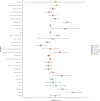Parkinson's disease determinants, prediction and gene-environment interactions in the UK Biobank
- PMID: 32934108
- PMCID: PMC7509524
- DOI: 10.1136/jnnp-2020-323646
Parkinson's disease determinants, prediction and gene-environment interactions in the UK Biobank
Abstract
Objective: To systematically investigate the association of environmental risk factors and prodromal features with incident Parkinson's disease (PD) diagnosis and the interaction of genetic risk with these factors. To evaluate whether existing risk prediction algorithms are improved by the inclusion of genetic risk scores.
Methods: We identified individuals with an incident diagnosis of PD (n=1276) and controls (n=500 406) in UK Biobank. We determined the association of risk factors with incident PD using adjusted logistic regression models. We constructed polygenic risk scores (PRSs) using external weights and selected the best PRS from a subset of the cohort (30%). The PRS was used in a separate testing set (70%) to examine gene-environment interactions and compare predictive models for PD.
Results: Strong evidence of association (false discovery rate <0.05) was found between PD and a positive family history of PD, a positive family history of dementia, non-smoking, low alcohol consumption, depression, daytime somnolence, epilepsy and earlier menarche. Individuals with the highest 10% of PRSs had increased risk of PD (OR 3.37, 95% CI 2.41 to 4.70) compared with the lowest risk decile. A higher PRS was associated with earlier age at PD diagnosis and inclusion of the PRS in the PREDICT-PD algorithm led to a modest improvement in model performance. We found evidence of an interaction between the PRS and diabetes.
Interpretation: Here, we used UK Biobank data to reproduce several well-known associations with PD, to demonstrate the validity of a PRS and to demonstrate a novel gene-environment interaction, whereby the effect of diabetes on PD risk appears to depend on background genetic risk for PD.
© Author(s) (or their employer(s)) 2020. Re-use permitted under CC BY. Published by BMJ.
Conflict of interest statement
Competing interests: None declared.
Figures




Comment in
-
Genetic-environmental factors finally assessed together in Parkinson's disease.J Neurol Neurosurg Psychiatry. 2020 Oct;91(10):1030. doi: 10.1136/jnnp-2020-324472. J Neurol Neurosurg Psychiatry. 2020. PMID: 32934106 No abstract available.
